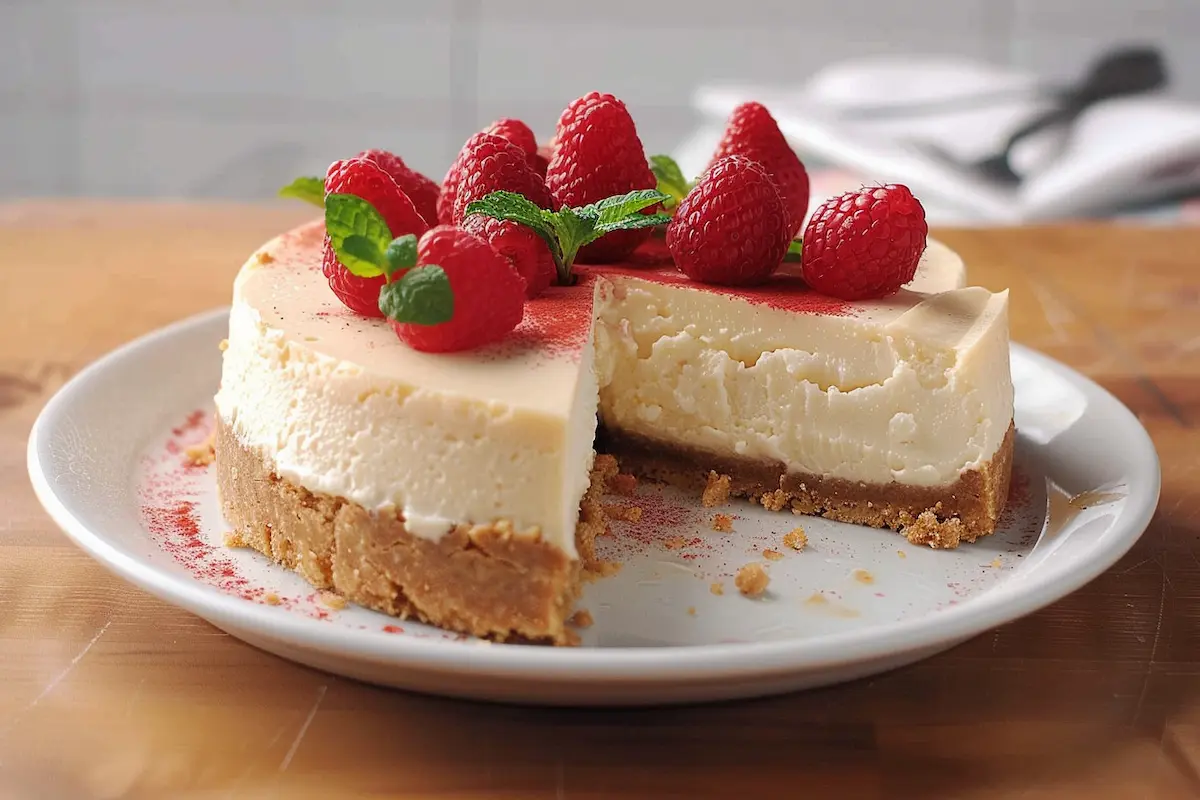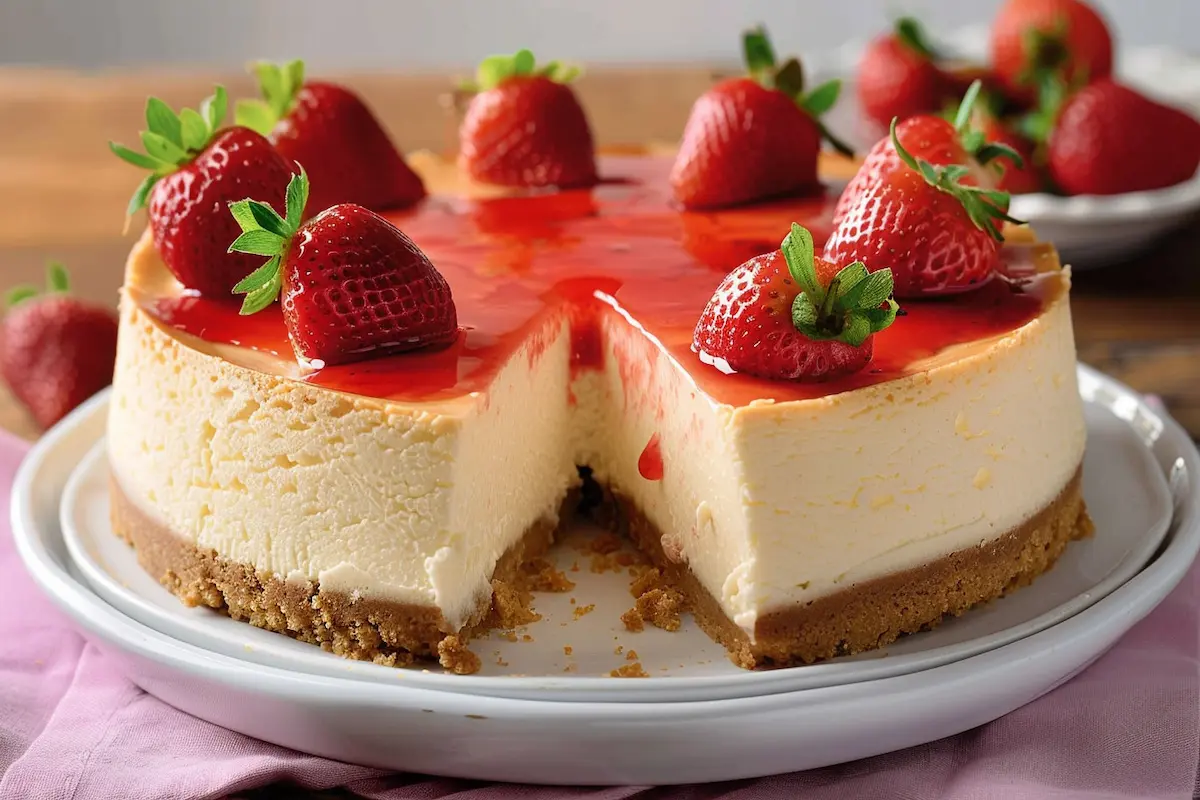Philadelphia Cheesecake Recipe is celebrated for its rich, velvety texture and distinct cream cheese flavor. Made with the iconic Philadelphia cream cheese, it has become synonymous with indulgence and is a go-to dessert for many. Whether you’re a seasoned baker or a beginner, this comprehensive guide will walk you through every step of the process to make a perfect cheesecake, from selecting ingredients to mastering baking techniques and beyond.
If you’re a cheesecake enthusiast, be sure to explore other indulgent variations like this Ultimate Blackberry Cheesecake or experiment with fun fusion desserts like Banana Pudding Crunch Cheesecake.
Table of Contents
- Essential Ingredients for Philadelphia Cheesecake
- Step-by-Step Instructions
- Pro Tips for Cheesecake Success
- Cheesecake Variations to Try
- Topping Ideas for Your Cheesecake
- Serving and Storing Cheesecake
- Common Cheesecake Questions Answered
- Internal Links for More Dessert Inspiration

Essential Ingredients for Philadelphia Cheesecake Recipe
A Philadelphia Cheesecake only needs a few ingredients, but it’s important to use the best-quality products for the ultimate flavor and texture. Philadelphia cream cheese is key, providing that smooth, tangy taste that makes this cheesecake so famous.
Crust Ingredients:
- 2 cups graham cracker crumbs
- 1/4 cup sugar
- 1/2 cup melted butter
Cheesecake Filling:
- 4 (8-ounce) packages of Philadelphia cream cheese, softened
- 1 cup granulated sugar
- 1 teaspoon vanilla extract
- 4 large eggs
Note: For a gluten-free version, you can substitute graham crackers with gluten-free alternatives, or make a nut-based crust using almond flour and butter.
Step-by-Step Instructions
Step 1: Preparing the Crust
- Preheat your oven to 325°F (165°C).
- Mix the graham cracker crumbs, sugar, and melted butter in a bowl until well combined.
- Press the mixture into the bottom of a 9-inch springform pan, ensuring an even layer.
- Bake the crust for 10 minutes, then set it aside to cool.
If you’d like to switch things up, you can try a Shortbread Cookie Crust for a richer, buttery flavor that complements the creamy cheesecake filling.
Step 2: Making the Cheesecake Filling
- Using a hand mixer or stand mixer, beat the softened Philadelphia cream cheese until smooth.
- Gradually add the granulated sugar and mix until fully incorporated.
- Add the vanilla extract and mix again.
- Beat in the eggs one at a time, mixing on low speed until just combined. Be careful not to overmix to prevent adding too much air into the batter, which can cause cracks.
Step 3: Baking the Cheesecake
- Pour the cheesecake filling over the cooled crust and smooth the top with a spatula.
- For the best results, bake the cheesecake in a water bath. Wrap the bottom of the springform pan in two layers of aluminum foil, then place it in a large roasting pan. Pour hot water into the roasting pan until it reaches halfway up the sides of the springform pan.
- Bake for 55-65 minutes, or until the edges are set and the center is slightly jiggly.
- Turn off the oven and let the cheesecake cool in the oven for 1 hour with the door slightly open to prevent cracking.
- Once the cheesecake is fully cooled, refrigerate for at least 4 hours or overnight for the best texture.
Pro Tips for Cheesecake Success
Even with the best recipe, a few missteps can turn a perfect cheesecake into a cracked or dense disaster. These tips will help ensure your Philadelphia Cheesecake Recipe turns out smooth and creamy every time.
Use Room-Temperature Ingredients
Cold cream cheese will create lumps in your cheesecake filling. Make sure to leave your cream cheese and eggs at room temperature for at least 30 minutes before starting to mix. This simple step makes a big difference in achieving a smooth, creamy texture.
Don’t Overmix the Batter
Overmixing can introduce air into the batter, leading to cracks or a dense texture. Mix just until all ingredients are incorporated and no more. This will help keep your cheesecake light and prevent it from puffing up and then collapsing as it cools.
Use a Water Bath
Baking the cheesecake in a water bath creates a moist, gentle heat that helps prevent cracking. If you’re nervous about water seeping into the pan, you can also place a pan of hot water on the oven rack below the cheesecake to add moisture to the oven.
Cool Gradually
Once baked, let your cheesecake cool gradually. Turn off the oven, prop open the door, and leave the cheesecake in the oven for an hour. This will help prevent any sudden temperature changes that can cause cracks.
Related Tip: If you’re worried about cracks, you can always cover them with a topping. Whether it’s whipped cream or fresh fruit, a crack or two doesn’t affect the taste.
Cheesecake Variations to Try
The beauty of Philadelphia Cheesecake Recipe is its versatility. You can easily customize the classic recipe to suit your tastes or experiment with new flavors. Here are some delicious variations to consider:
1. Chocolate Swirl Cheesecake
For chocolate lovers, melt 4 ounces of semi-sweet chocolate and swirl it into the cheesecake filling before baking. The result is a decadent marbled effect with bursts of chocolate in every bite.
2. Lemon Cheesecake
Add a burst of citrus flavor by mixing the zest of two lemons and 2 tablespoons of lemon juice into the cheesecake batter. This is perfect for those who prefer a lighter, tangier dessert.
3. Oreo Cheesecake
For a fun twist, fold crushed Oreos into the cheesecake filling and use Oreo cookies for the crust. Check out this No-Bake Oreo Cheesecake if you’re looking for an easy, no-bake version of this beloved dessert.
4. Fruit-Topped Cheesecake
Top your cheesecake with a layer of fresh fruit or a homemade fruit compote. Berries, such as strawberries, raspberries, or blueberries, work especially well. For a more complex flavor, try this Ultimate Blackberry Cheesecake, which incorporates fresh blackberries into the filling.
Topping Ideas for Your Cheesecake
Toppings can take your cheesecake from delicious to extraordinary. Here are some ideas to inspire you:
1. Berry Compote
A berry compote is a simple yet flavorful topping. Combine fresh or frozen berries with a little sugar and lemon juice, then cook over medium heat until the mixture thickens. Spoon the compote over your cheesecake for a pop of color and flavor.
2. Salted Caramel
Drizzle homemade salted caramel sauce over your cheesecake for a rich, sweet-salty contrast. You can make your own with sugar, butter, and cream, or use store-bought caramel sauce for convenience. Try adding a pinch of sea salt for extra depth.
Related Recipe: For a more indulgent dessert, check out this Banana Pudding Crunch Cheesecake, which layers banana pudding and crunchy topping with classic cheesecake.
3. Whipped Cream
For a light and fluffy topping, whipped cream is always a winner. Add a hint of vanilla extract or a splash of bourbon for a more sophisticated flavor. Pipe the whipped cream onto individual slices for a professional presentation.
4. Chocolate Ganache
For chocolate lovers, melt semi-sweet chocolate with heavy cream to create a smooth ganache. Pour it over the chilled cheesecake for a glossy, decadent finish that pairs beautifully with the creamy filling.

Serving and Storing Cheesecake
Once your cheesecake has set in the fridge, it’s time to serve and enjoy! To achieve clean, professional-looking slices, dip a sharp knife in hot water, wipe it clean between each cut, and serve.
How to Serve
You can serve Philadelphia Cheesecake Recipe on its own or pair it with a variety of toppings for extra flavor. A cheesecake bar is a fun option for parties—set out bowls of different toppings like fresh fruit, caramel, and whipped cream, and let your guests customize their slices.
If you’re hosting a larger event, mini cheesecakes are also a great idea. Use a muffin tin to create individual-sized cheesecakes, each topped with a different flavor, so everyone can try multiple varieties. Check out this Blueberry Cheesecake Rolls Recipe for a fun twist on mini cheesecakes!
Storing Cheesecake
Cheesecake can be stored in the refrigerator for up to 5 days. Make sure it’s covered to prevent it from absorbing any odors. If you want to freeze it, wrap individual slices in plastic wrap and then in aluminum foil. Frozen cheesecake will keep for up to 3 months.
To thaw, transfer the cheesecake slices to the fridge overnight. You can also enjoy frozen cheesecake as an ice cream-like treat on a hot day!
Common Cheesecake Questions Answered
Q: How do I know when my cheesecake is done? A: The cheesecake is done when the edges are set, but the center still jiggles slightly. The residual heat will finish cooking the center as it cools.
Q: Why did my cheesecake crack? A: Cracks can occur if the cheesecake is overbaked, the oven temperature fluctuates, or the filling was overmixed. Using a water bath and letting the cheesecake cool gradually can help prevent cracks.
Q: Can I make this cheesecake without a water bath? A: Yes, but the water bath creates a more even temperature and helps prevent cracks. If you skip it, try placing a pan of hot water on the rack below the cheesecake to add moisture to the oven.
Q: Can I use low-fat cream cheese? A: Yes, but the texture and flavor won’t be as rich and creamy. For the best results, stick with full-fat Philadelphia cream cheese.

Internal Links for More Dessert Inspiration
Looking for more mouth-watering dessert ideas? Check out these recipes for even more cheesecake goodness:
- Ultimate Blackberry Cheesecake: If you love the combination of sweet and tart, this recipe is a must-try.
- No-Bake Oreo Cheesecake: A quick and easy cheesecake that requires no baking and is packed with cookies-and-cream goodness.
- Banana Pudding Crunch Cheesecake: A fun twist on the classic cheesecake, combining banana pudding with a crunchy topping.
By linking to these related articles, you can keep your readers engaged and introduce them to new recipes that they’re sure to love.

